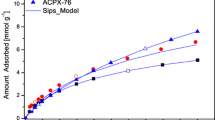Abstract
Of thermosetting polymers, polyphenylene oxide (PPO) is considered as one of the promising alternative polymeric precursors for carbon membrane preparation. In this study, the PPO derived carbon membranes were prepared by carbonization and followed by air-oxidation as post-treatment method to modify the membrane pore structures. The characterization of the pore properties showed that air-oxidation enlarged the pore structure for the postoxidized carbon materials. The permeation results for the post-oxidized carbon membranes showed that the extent of the permeation modification was strongly dependent on the oxidation temperature. In the binary mixture gas systems, the permeation performance of the adsorbing gas species increased due to the surface diffusion mechanism. It is considered in the oxidation effect on the permeation modification that the post-oxidation of the carbon membranes increased gas permeation and separation properties.
Similar content being viewed by others
References
Centeno, T. A. and Fuertes, A. B., “Carbon molecular sieve membranes derived from a phenolic resin supported on porous ceramic tubes,”Sep. Purif. Technol.,25, 379 (2001).
Fuertes, A. B., “Adsorption-selective carbon membrane for gas separation,”J. Membr. Sci.,177, 9 (2000).
Fuertes, A. B., “Effect of air oxidation on gas separation properties of adsorption-selective carbon membranes,”Carbon,39, 697 (2001).
Fuertes, A. B. and Menendez, I., “Separation of hydrocarbon gas mixtures using phenolic resin-based carbon membranes,”Sep. Purif. Technol.,28, 29 (2002).
Hamad, F. A., Chowdhury, G. and Matsuura, T., “Sulfonated polyphenylene oxide-polyethersulfone thin-film composite membranes: effect of counterions on the gas transport properties,”J. Membr. Sci.,191, 71 (2001).
Hasegawa, Y., Tanaka, T. and Watanabe, K., “Separation of CO2-CH4 and CO2-N2 system using ion-exchange FAU-zeolite membrane with different Si/Al ratios,”Korean J. Chem. Eng.,19, 309 (2002).
Ismail, A. F. and David, L. I. B., “A review on the latest development of carbon membranes for gas separation,”J. Membr. Sci.,193, 1 (2001).
Jung, K. Y., So, J. H., Park, S. B. and Yang, S. M., “Hydrogen separation from the H2/N2 mixture by using a single and multi-stage inorganic membrane,”Korean J. Chem. Eng.,16, 193 (1999).
Kim, Y. K., Park, H. B. and Lee, Y. M., “Carbon molecular sieve membranes derived from metal-substituted sulfonated polyimide and their gas separation properties,”J. Membr. Sci.,226, 145 (2003).
Kim, Y. K., Park, H. B. and Lee, Y. M., “Carbon molecular sieve membranes derived from thermally labile polymer containing blend polymers and their gas separation properties,”J. Membr. Sci.,243, 9 (2004).
Kim, Y. K., Park, H. B. and Lee, Y. M. “Gas separation properties of carbon molecular sieve membranes derived from polyimide/polypyrrolidone blends: effect of the molecular weight of polyvinylpyrrrolidone,”J. Membr. Sci.,251, 159 (2005).
Kim, Y. S., Kusakabe, K., Morooka, S. and Yang, S. M., “Preparation of microporous silica membranes for gas separation,”Korean J. Chem. Eng.,18, 106 (2001).
Kim, S. S. and Sea, B. K., “Gas permeation characteristics of silica/alumina composite membrane prepared by chemical vapor deposition,”Korean J. Chem. Eng.,18, 322 (2001).
Koros, W. J. and Mahajan, R., “Pushing the limits on possibilities for large scale gas separation: Which strategies?”J. Membr. Sci.,175, 181 (2000).
Kruczek, B. and Matsuura, T., “Effect of metal substitution of high molecular weight sulfonated polyphenylene oxide membranes on their gas separation performance,”J. Membr. Sci.,167, 203 (2000).
Lee, K. H. and Hwang, S. T., “The transport of condensible vapors through a microporous vycor glass membrane,”J. Colloid Interf. Sci.,110, 544 (1986).
Moon, J. H., Ahn, H., Hyun, S. H. and Lee, C. H., “Separation characteristics of tetrapropylammoniumbromide templating silica/alumina composite membrane in CO2/N2, CO2/H2 and CH4/H2 systems,”Korean J. Chem. Eng.,21, 477 (2004).
Rao, M. B. and Sircar, S., “Performance and pore characterization of nanoporous carbon membranes for gas separation,”J. Membr. Sci.,110, 109 (1996).
Robeson, L. M., “Correlation of separation factor versus permeability for polymeric membranes,”J. Membr. Sci.,62, 165 (1991).
Saufi, S. M. and Ismail, A. F., “Fabrication of carbon membranes for gas separation — a Review,”Carbon,42, 241 (2004).
Shusen, W., Meiyun, Z. and Zhizhong, W., “Asymmetric molecular sieve carbon membranes,”J. Membr. Sci.,109, 267 (1996).
Sing, K. S.W., Everett, D. H., Haul, R. A. W., Mosocou, L., Pirtotti, R. A., Rouqurol, J. and Siemieniewska, T., “Reporting physisorption data for gas/solid systems,”Pure & Appl. Chem.,57, 603 (1985).
Sircar, S., Rao, M. B. and Thaeron, C. M. A., “Selective surface flow membrane for gas separation,”Sep. Sci. Technol.,34, 2081 (1999).
Story, B. and Koros, W. J., “Sorption and transport of CO2 and CH4 in chemically modified poly(phenylene oxide),”J. Membr. Sci.,67, 191 (1992).
Suda, H. and Haraya, K., “Gas permeation through micropores of carbon molecular sieve membranes derived from kapton polyimide,”J. Phys. Chem. B,101, 3988 (1997).
Suda, H. and Haraya, K., “Carbon molecular sieve membranes: preparation, characterization, and gas permeation properties,”ACS Symposium Series,744, 295 (2000).
Yamamoto, M., Kusakabe, K., Hayashi, J. and Morooka, S., “Carbon molecular sieve membrane formed by oxidative carbonization of a copolyimide film coated on a porous support tube,”J. Membr. Sci.,133, 195 (1997).
Author information
Authors and Affiliations
Corresponding author
Rights and permissions
About this article
Cite this article
Lee, HJ., Suda, H., Haraya, K. et al. Influence of oxidation temperature on the gas permeation and separation properties in a microporous carbon membrane. Korean J. Chem. Eng. 23, 435–440 (2006). https://doi.org/10.1007/BF02706746
Received:
Accepted:
Issue Date:
DOI: https://doi.org/10.1007/BF02706746




